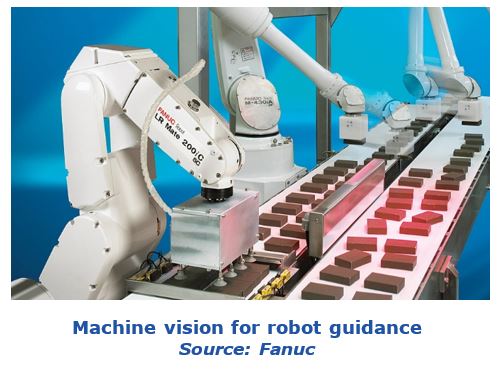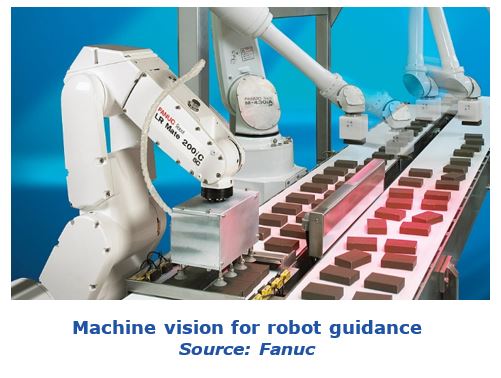Major Machine Vision Trends for 2020
Blog: NASSCOM Official Blog
The trend towards robotics and smart manufacturing makes machine vision technology an indispensable tool for industrial automation. Machine vision technology has gradually  replaced quality inspection performed by humans. The technology provides object recognition capabilities with varying degrees of accuracy and reliability. Manufacturers employ machine vision to improve the traceability of their products for enhanced consistency, productivity, and overall quality. This desire for quality has manifested itself as consumers demand goods without defects or errors. Manufacturers expect zero defects from Tier 1 suppliers of subassembly components; manufacturers seek high quality of “pass through production” from outsourcing suppliers and internal production lines. Industries where product defects could result in injury or death have regulatory requirements necessitating the use of vision. With IIoT or Industrie 4.0, smart machines, inventory systems, and production machinery will considerably improve industrial processes, driving the use of more automation products, such as machine vision systems.
replaced quality inspection performed by humans. The technology provides object recognition capabilities with varying degrees of accuracy and reliability. Manufacturers employ machine vision to improve the traceability of their products for enhanced consistency, productivity, and overall quality. This desire for quality has manifested itself as consumers demand goods without defects or errors. Manufacturers expect zero defects from Tier 1 suppliers of subassembly components; manufacturers seek high quality of “pass through production” from outsourcing suppliers and internal production lines. Industries where product defects could result in injury or death have regulatory requirements necessitating the use of vision. With IIoT or Industrie 4.0, smart machines, inventory systems, and production machinery will considerably improve industrial processes, driving the use of more automation products, such as machine vision systems.
Machine Vision Trends for 2020
3D Imaging
3D image processing has been steadily growing technology within machine vision. The availability of variety of components have exploded in past few years and these components are becoming more sophisticated and targeted for specific application bases such as robot guidance, high speed imaging and surface profiling. These applications require extremely accurate and reliable 3D images. There has been proliferation of 3D imaging technology, like stereo vison, time of flight and structured lights. Structured light with stereo vision has begun to penetrate the 3D segment. 3D structured light solutions are being applied to robotic tasks, such as navigation and path planning. Most of the established vendors, such as Keyence and Wenglor, have built their systems on the structured light principle. The market is also witnessing several new players, such as Photoneo, Zivid, and Canon, entering the 3D technology segment with structured light technology.
Deep Learning
Deep learning is revolutionizing the role of machine vision in industrial automation and smart manufacturing. The integration of deep learning has enabled machine vision systems to adapt autonomously to manufacturing variations. This has radically improved the value proposition for machine vision by improving operational efficiencies, accelerating inspection processes, and increasing productivity in applications that were not cost-effective to strive for in the past. Deep learning solves vision applications difficult to program with rule-based algorithms, and it handles complex surface textures and variations in part appearance and acclimatizes to new examples without re-programming core networks. This technology effectively handles judgment-based part location, inspection, classification, and character recognition challenges efficiently when compared to conventional machine vision systems.
Embedded Vision
Adoption of embedded vision is continuing to be broadly applied in the consumer sector. ARC’s expectation is that embedded vision will also be adopted in the industrial sector during the forecast period. Embedded systems are compact systems constituting miniaturized PCs or processing board and powerful board level cameras designed for a specific application known as embedded vision systems. These systems are gaining traction because of their characteristics, such as light weight, small size, low cost, low energy consumption, and user friendliness. Embedded systems find applications in autonomous mobile robots, driver assistance systems, industrial drones, biometrics, medical imaging, and space imaging. One of the evolving applications of these systems is in robotics. An embedded vision system improves capability and productivity of robotic assembly applications, inspection tasks, and autonomous navigation. This technology plays a crucial role in 3D mapping for safe, reliable navigation of robots in new and diverse environments.
Robotics
Robotic solutions address the seemingly insatiable demand in manufacturing to increase flexibility, improve productivity, and employ human operators only in tasks where they can add the most value. The demand for robotics has diversified across a broader range of industries. While robotics is a relatively mature technology in the automotive industry, there has been an increased usage in food & beverage, electronics, healthcare, and logistics. Machine vision systems are employed in a robot for recognizing and viewing objects. 3D machine vision in conjunction with robotics is providing guidance and location for a wide range of assembly and inspection applications. Powerful cameras, faster vision processors and advanced software have allowed robots to complete more than one task without reprogramming. . The technology delivers accurate real-time location data, enabling robots to be more independent and flexible and adapt to changes. With the demand for robots and robotic applications expected to accelerate in the years to come, sale of machine vision systems will proliferate during the forecast period.
“Reprinted with permission, original blog was posted here”. You may also visit here for more such insights on the digital transformation of industry.
About ARC Advisory Group (www.arcweb.com): Founded in 1986, ARC Advisory Group is a Boston based leading technology research and advisory firm for industry and infrastructure.
For further information or to provide feedback on this article, please contact RPaira@arcweb.com
About the Author:
Anju Ajaykumar
Anju’s areas of focus include AC drives, machine vision systems, machine safeguarding solutions, and coordinate measuring machines.
Before joining ARC, Anju was associated with leading analyst firms with a focus on various topics cutting across power, battery energy storage systems, and engineered products. She was responsible for conducting market assessment and competitive analysis by closely tracking key industry developments and trends in the related areas and had authored several syndicated global and regional reports.
The post Major Machine Vision Trends for 2020 appeared first on NASSCOM Community |The Official Community of Indian IT Industry.


 replaced quality inspection performed by humans. The technology provides object recognition capabilities with varying degrees of accuracy and reliability. Manufacturers employ machine vision to improve the traceability of their products for enhanced consistency, productivity, and overall quality. This desire for quality has manifested itself as consumers demand goods without defects or errors. Manufacturers expect zero defects from Tier 1 suppliers of subassembly components; manufacturers seek high quality of “pass through production” from outsourcing suppliers and internal production lines. Industries where product defects could result in injury or death have regulatory requirements necessitating the use of vision. With IIoT or Industrie 4.0, smart machines, inventory systems, and production machinery will considerably improve industrial processes, driving the use of more automation products, such as machine vision systems.
replaced quality inspection performed by humans. The technology provides object recognition capabilities with varying degrees of accuracy and reliability. Manufacturers employ machine vision to improve the traceability of their products for enhanced consistency, productivity, and overall quality. This desire for quality has manifested itself as consumers demand goods without defects or errors. Manufacturers expect zero defects from Tier 1 suppliers of subassembly components; manufacturers seek high quality of “pass through production” from outsourcing suppliers and internal production lines. Industries where product defects could result in injury or death have regulatory requirements necessitating the use of vision. With IIoT or Industrie 4.0, smart machines, inventory systems, and production machinery will considerably improve industrial processes, driving the use of more automation products, such as machine vision systems.





